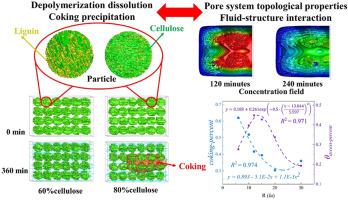Investigation of particle structural characteristics effects on coking behavior in cellulose hydrolysis
IF 5.8
2区 生物学
Q1 AGRICULTURAL ENGINEERING
引用次数: 0
Abstract
Continuous flow depolymerization offers a sustainable pathway for converting biomass into energy-dense fuels, addressing challenges such as coking and mass transfer inefficiencies that hinder biomass's viability as a renewable fuel feedstock. Here, a three-dimensional lattice Boltzmann model reveals how multiparticle lignocellulose configurations in fixed-bed reactors govern flow-structure evolution. By achieving equilibrium between intra- and extra-particle mass transfer, this approach enhances hydrogen ion diffusion—essential for catalytic biofuel synthesis—while reducing coking-induced energy losses. The lignin-first strategy further improves reactor performance by intensifying fluid-solid interactions, thereby advancing transport kinetics critical for scalable biofuel production. These structural engineering principles enable efficient biomass-to-fuel conversion with minimized humins formation, directly supporting cleaner energy outputs and circular economy goals in renewable fuel manufacturing.

纤维素水解过程中颗粒结构特征对焦化行为影响的研究
连续流动解聚为生物质转化为高能量燃料提供了一条可持续的途径,解决了阻碍生物质作为可再生燃料原料可行性的焦化和传质效率低下等挑战。在这里,三维晶格玻尔兹曼模型揭示了固定床反应器中的多粒子木质纤维素结构如何控制流动结构演化。通过实现粒子内和粒子外传质之间的平衡,这种方法增强了氢离子扩散——催化生物燃料合成的必要条件——同时减少了焦化引起的能量损失。木质素优先策略通过加强流固相互作用进一步提高了反应器性能,从而推进了可扩展生物燃料生产的关键运输动力学。这些结构工程原理使生物质能有效地转化为燃料,最大限度地减少了人类的形成,直接支持更清洁的能源产出和可再生燃料制造的循环经济目标。
本文章由计算机程序翻译,如有差异,请以英文原文为准。
求助全文
约1分钟内获得全文
求助全文
来源期刊

Biomass & Bioenergy
工程技术-能源与燃料
CiteScore
11.50
自引率
3.30%
发文量
258
审稿时长
60 days
期刊介绍:
Biomass & Bioenergy is an international journal publishing original research papers and short communications, review articles and case studies on biological resources, chemical and biological processes, and biomass products for new renewable sources of energy and materials.
The scope of the journal extends to the environmental, management and economic aspects of biomass and bioenergy.
Key areas covered by the journal:
• Biomass: sources, energy crop production processes, genetic improvements, composition. Please note that research on these biomass subjects must be linked directly to bioenergy generation.
• Biological Residues: residues/rests from agricultural production, forestry and plantations (palm, sugar etc), processing industries, and municipal sources (MSW). Papers on the use of biomass residues through innovative processes/technological novelty and/or consideration of feedstock/system sustainability (or unsustainability) are welcomed. However waste treatment processes and pollution control or mitigation which are only tangentially related to bioenergy are not in the scope of the journal, as they are more suited to publications in the environmental arena. Papers that describe conventional waste streams (ie well described in existing literature) that do not empirically address ''new'' added value from the process are not suitable for submission to the journal.
• Bioenergy Processes: fermentations, thermochemical conversions, liquid and gaseous fuels, and petrochemical substitutes
• Bioenergy Utilization: direct combustion, gasification, electricity production, chemical processes, and by-product remediation
• Biomass and the Environment: carbon cycle, the net energy efficiency of bioenergy systems, assessment of sustainability, and biodiversity issues.
 求助内容:
求助内容: 应助结果提醒方式:
应助结果提醒方式:


